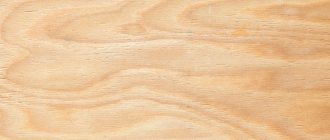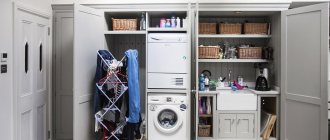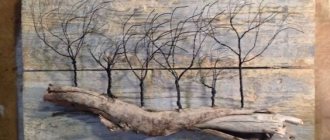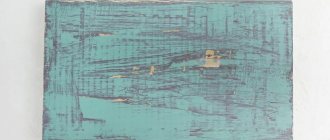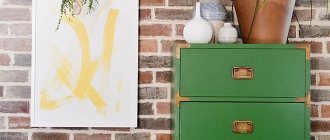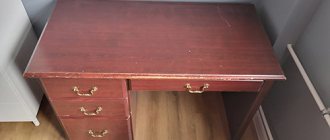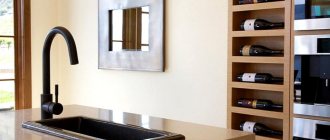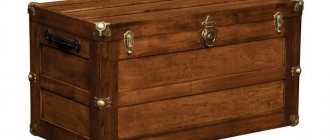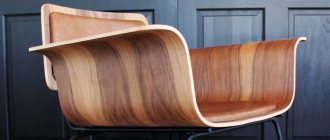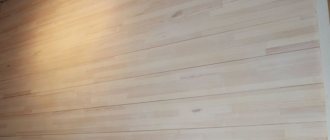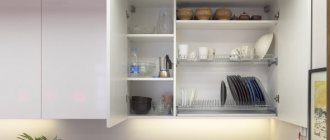Plywood is considered a popular material for decoration, as well as for furniture production. Demand for it is growing due to its low cost, and the material itself consists of several thin sheets of veneer glued together. When carrying out repair work, painting of plywood is often required: in order to do this efficiently, you need to familiarize yourself with the sequence of the procedure, as well as choose the right paint composition.
Painting plywood
Preparing the surface for painting
Plywood panels are an environmentally friendly and affordable material, so they can be used in any area for repairs. Before you paint plywood, you need to properly process it yourself. Then the adhesion of the material to the coating will improve, and the paint and varnish composition will lie beautifully and evenly.
Raw materials are often sold in this form in warehouses: they may or may not be polished. Depending on this, a list of preparatory work for painting is determined.
The entire technology for preparing a product for painting consists of processing the material: cleaning and sanding it, as well as priming and puttying.
Primer for plywood
Features of the material
The main feature of plywood is its ability to absorb moisture. Because of this, untreated material quickly loses its quality and attractive appearance. To protect against high humidity and extend its service life, plywood must be painted.
Several types of plywood are produced according to the degree of resistance to external influences:
Plywood is divided into 5 grades based on the quality of the material from which it is made and the amount of preparatory work required before painting:
The method of finishing plywood is determined by its grade:
Cleaning and sanding the material
When purchasing raw materials, you should pay attention to its texture: if it is very rough, the material must be cleaned and sanded. Before painting the plywood yourself, experts recommend drying it. Most likely, the sheets of material were sold from a warehouse, and it was often humid and damp there, so the wood could absorb some of the moisture. It is not possible to dry the product quickly, so the sheets of material are sent to a dry and warm place for 3 days.
With this tool you can sand small surfaces. If the sheets of material are large, it is better to use a power tool.
Once the plywood has dried, you can begin preparing it:
- Cleaning. This simple process is carried out to ensure that no large specks or contaminants remain on the surface of the raw material. Plywood can absorb moisture, so do not use water when cleaning. High-quality wood will always have a distinctive pattern - you also need to walk over it and check for contamination. Dirt must be removed using a coarse brush.
- Sanding. This procedure requires perseverance and care. Sanding consists of two stages: the first involves sanding with coarse-grain sandpaper, and the second with fine-grain sandpaper. The important thing here is to achieve not beauty, but a smooth surface. According to the advice of the masters, it is better to use a special grinding machine - this will speed up the work.
After passing coarse grain across the surface, it is necessary to change the nozzle to paper with fine dispersion. This procedure can easily be carried out manually, but it will take more time. Don't forget about the edges of the product - they also need to be cleaned and sanded.
Varnishing plywood
Recommendations for varnishing
When starting to process the canvas, you should take into account some nuances. To get a good result and avoid unpleasant consequences, you need to:
The composition should be applied evenly in the direction of the wood fibers
- when painting plywood with acrylic paint indoors, cover furniture and floors that cannot be treated with polyethylene;
- choose a suitable putty to match the pigment used;
- apply the composition evenly along the wooden fibers;
- do not allow the formation of too thick a layer of pigment, which leads to the appearance of smudges;
- apply the composition in two layers if you need to create a rich shade;
- Use masking tape when combining different colors.
Surface priming and puttying
The next two stages of preparing plywood for paint treatment are priming and puttying. It is necessary to paint plywood with a primer in order to fill all existing voids on the surface: this will prevent further cracking of the material. Before applying the composition, degreasing is carried out so that no extra pieces of wood remain on the material. It is necessary to prime the plywood in 3-4 layers. When further painting it in a transparent color, the craftsmen recommend additionally applying several layers of antiseptic and fire retardant on top of the primer - they will protect the product from fire and prevent it from turning blue.
Priming can be done using a small brush and a pre-selected primer material.
It is necessary to cover the plywood with a new layer of primer only after the previous layer has completely dried. This work may take several days. When the priming procedures are completed, it is recommended to thoroughly dry the material again. The correct technology for preparing for painting contains one more step - puttying. Plywood especially needs additional protection, and it is the putty that will protect the coating from mechanical damage in the future.
Sanding plywood
The process looks like this:
- White acrylic putty is used for work. Due to the fact that plywood is often used to level various types of surfaces (floor, ceiling or walls), mechanical protection will not be superfluous. It is the acrylic base that makes the plywood moisture resistant, which makes it possible to use it in damp rooms by attaching it to a slatted frame.
- Tools and application. To work you need a spatula and a rule. The putty is applied in small strokes, after which the layer is usually leveled. The optimal coating thickness is 2-3 mm, with special attention should be paid to joints and recesses.
At the priming stage, before filling, you can apply a stain to the surface of the material - this will also additionally protect it.
Spray painting
How to paint plywood
Painting plywood correctly is not difficult. We have already talked about applying paint according to the arrangement of the fibers. You can also take a completely traditional tool: a roller, sprayer or paint brush.
Let's consider in which case it is more appropriate to choose each of these options:
Ideal for saving time and large amounts of space, such as floors, ceilings, facades;
Convenient for painting medium-sized areas, such as a plywood cabinet, for example. As for the material of the roller coat, it is better to choose foam rubber for plywood;
A universal tool that can be found in every home. Ideally paints hard-to-reach places (corners), ends and shaped elements.
Coloring
The layer is applied evenly to the surface, and it should be thin. Otherwise, you risk getting smudges, which will undoubtedly spoil the appearance. In addition, a thin coating gives the paint a richer color.
It is better to apply the paint in two successive layers. It is important to remember that the second one is always applied after the first one has completely dried.
Applying varnish
Sometimes varnish is used instead of paint. The plywood is first cleaned and sanded using sandpaper or a sanding machine, then it must be cleaned of any accumulated dust and degreased. Otherwise, all dirt will be visible under the varnish.
After applying the first layer of varnish, let it dry. Sand the first layer and then cover the surface with another layer. As a result of this approach, varnished plywood becomes dull.
If you want to get a glossy surface, you need to apply another layer of varnish on top. This time it is advisable to apply it using a sprayer to evenly distribute the varnish composition.
The nuances of painting white
To paint white or any other light color, you should add similar dyes to the primer, thereby achieving the required color concentration.
Choosing paint or varnish for plywood
When choosing what to paint plywood for decoration or finishing, it is recommended to pay attention to the subsequent conditions of its use. If the material will be used outdoors, it is better to choose oil-based compounds and waterproof varnish. When using the material indoors, acrylic or water-based paint is suitable. Depending on the final result, you can use either an aerosol can or a spray gun. If you need to make an inscription, then an airbrush is good.
Some tips for choosing paint:
- You can use oil-based enamel to paint external plywood slabs (this option is suitable for a summer house);
- Water-based paint can be used to cover the outside of houses, and this option can also be used to decorate furniture, since the composition is odorless;
- acrylic composition is good for painting plywood toys, children's crafts, doll houses, as well as decorating items for the interior;
- enamels, for example, PF-115, are made on the basis of pentaphthalic varnish; they are suitable for plywood that will be used in places with frequent temperature changes.
Coating the material with varnish is one of the most important steps in preventing mechanical damage.
The choice of varnish also has its secrets. For example, if you want to paint laminated plywood, giving it a wooden texture, powder dye is poured into the varnish: when applied to the surface, an interesting pattern is created. Transparent gloss varnish is best used when you plan to decorate plywood while maintaining the original appearance. The enamel composition must be used when the product is planned to be used continuously.
Correct coloring of plywood
When calculating how long it will take to complete the entire process of working with plywood, it is also worth considering its markings. When purchasing, it is worth checking the letter assigned to the material and its grade - this will help to avoid large amounts of time spent on preparation.
Painting process
The compounds are applied in a thin layer, avoiding drips and streaks.
Painting plywood is not difficult. It is important to follow the recommendations.
- For large areas, it is better to take a spray gun. If the surface to be painted is small, use brushes or rollers.
- Dilute the paint immediately before the procedure. If the composition dries quickly, make a minimum portion.
- Apply any paints and varnishes only along the wood fibers.
- If a more intense shade is required, apply in several layers, waiting for the previous one to dry.
You cannot apply a thick layer at once: the paint will harden unevenly, flow, and bubbles will form.
How to coat correctly
The stain is applied by rubbing.
There are several options for applying paintwork. The method is chosen depending on the viscosity and hiding power of the composition.
- It is better to apply stains with wax or oil mixtures by rubbing. A portion of the composition is poured onto the surface and carefully distributed with a sponge or roller.
- It is best to apply paint from a can. This way you get a very even thin layer.
- A foam roller is used when applying liquid compositions of low coverage. This allows you to avoid divorces.
- Thick paints and stains are applied with a paint brush to obtain a rich shade and emphasize the structure.
If oil stain is applied in several layers, after the first has dried, you need to sand the surface to remove any raised lint.
Wood imitation
Plywood products can be given the appearance of noble antiquity. There are a lot of methods. The simplest involves using a candle .
- Paint the sheet with the chosen color, apply strokes randomly in different directions.
- After drying, use a paraffin candle to wipe the sheet in the same way - in random or selected places.
- Apply a second layer of paint - a matching or contrasting shade. The plywood is covered evenly.
- While the paint is not dry, wipe the layer with a rag. In areas where there was wax, it is easily erased, in others it remains.
You can apply a third layer of paint or, after drying, varnish the plywood. It turns out to be a very interesting structure.
Features of painting white
Even with high hiding power of paint, it is difficult to obtain a pure white color . Plywood is prepared for this: primed with white mixtures and sanded. Matte paints are used for coating , since glossy ones do not hide, but highlight the slightest surface and color defects.
Drying
Drying plywood is a preliminary stage of work. This is done if you need to paint or varnish material brought from the cold. The sheets are placed in the room where they will be used and kept for about a day. If the material was stored or transported at a temperature difference of more than 10–15°C, it will take 3 days.
Painted plywood dries naturally. Hairdryer is not used .
Preparing tools and paint
In addition to the main painting tools, which must be thoroughly cleaned, auxiliary devices should be prepared. These will include the same trowel, a construction knife and equipment for supplying compressed air if you plan to use a pneumatic sprayer.
Next, the paint and varnish composition is prepared. Initially, it can be a liquid solution or a dry mixture. In both cases, thorough stirring and dilution with water is required.
It is important to consider that painting plywood will be of high quality only if the solution is uniform. It should be free of lumps and foreign bodies. If necessary, at this stage you can add modifiers to the composition that improve certain qualities of the mixture.
Instructions for applying the composition
If the choice falls on a brush or roller, then the actions should be performed smoothly and without jerking. It is recommended to cover as large an area as possible in one pass, which will minimize smudges and make the coating uniform. At the same time, it is better not to limit yourself to one layer - on average, this design is performed in 2-3 passes.
If you are preparing to paint a plywood floor, you should count on 5-6 layers, since this coating will require increased mechanical resistance. The easiest way to work is with a spray gun. It sprays the composition evenly over the entire area and the user can only monitor the abundance of coverage. In this case, leaks are also possible, but this effect can be avoided if you perform intensive movements of the working head of the tool.
Paint Application Methods
An experienced master will quickly be able to put a masterpiece on a tablet. Beginning artists can use our tips and use one of the technologies:
The stencil method is considered the simplest. First, they take a purchased or made stencil, press it to the product, trace it with a pencil and begin painting. Drawing using a template is very easy.
Sometimes, before making a drawing on a wooden blank, they make a test sketch on paper. This allows you to experiment with a variety of patterns: abstractions, geometric shapes, professional sketches.
You can also use dark or white transfer paper to apply designs to wood products. Carbon paper allows you to make a neat drawing. Whatever method you use, the resulting products will make a good gift or home decoration.
The third stage - varnishing the floor
After painting, the surface is covered with varnish, which gives the floor a glossy shine and protects the color from wearing off. To find out what varnish to paint plywood with, you need to familiarize yourself with the properties of the material - an alkyd-urethane base is used for the floor.
The plywood coating varnishing process consists of three stages:
The third stage is the most time-consuming, since the varnish coating completely dries on the 7th day after application. You can save time if you initially use gloss-based paint. In this case, varnishing is not necessary.
To avoid drips, apply the varnish in a thin layer. The movements of the brush should be directed according to the “pattern” of the wood - this contributes to the aesthetic appearance of the plywood after drying.
How to treat the surface → Room decoration → How to choose the right paint → Surface treatment technologies → Leveling and finishing the walls → Selecting and applying a primer → Removal from the surface → Stretch ceilings and technologies → Reviews and testimonials
Expert opinion
Strebizh Viktor Fedorovich, leading construction foreman
This is the main difficulty of working with water-based emulsion, since without special equipment it is almost impossible to make a wooden coating perfectly smooth; any slightest irregularities will still appear. If you want to clarify something, please contact me!
Step-by-step description of painting plywood
Plywood is considered a material that is quite in demand in various areas of people's lives. It can be used as a sealant, used for furniture production and floor leveling. The material is low in cost, and sheets of different thicknesses and sizes are available for sale.
In order to increase the service life of plywood, it is necessary to take care of high-quality protection. This can be done using coloring.
Not every specialist knows what is the best way to paint plywood. In this case, it is worth remembering a few simple recommendations that will help you choose the right composition for coloring. Since plywood is a sheet material, it is based on wood. Under the influence of various factors, the characteristics of the material may deteriorate over time, so you need to treat coloring as responsibly as possible and follow the following instructions.
Tool
You should first prepare the tools for painting plywood. You can use a brush, roller or spray gun. You will also need a container into which you can pour paint for more convenient use.
